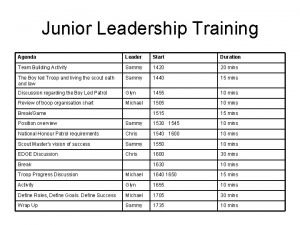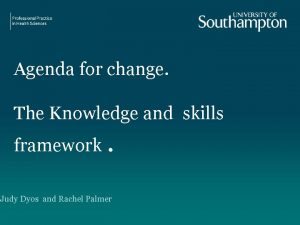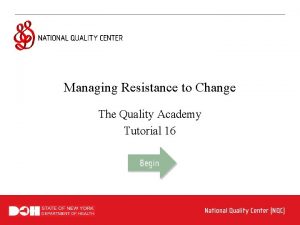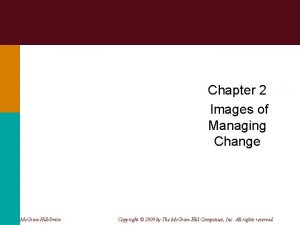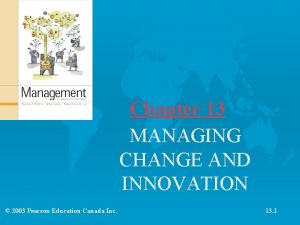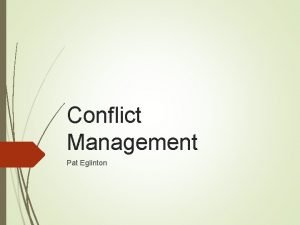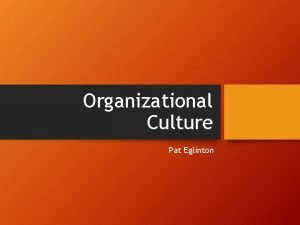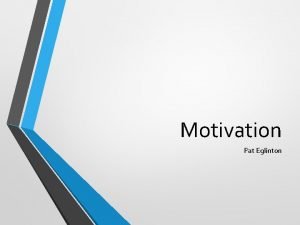MANAGING CHANGE PAT EGLINTON AGENDA Change Leadership Managing












- Slides: 12

MANAGING CHANGE PAT EGLINTON

AGENDA “Change Leadership” Managing Change Articles Strategic Change Leadership Why Do Employees Resist Change? Change Management? – Or Change Leadership? Exercises and Practice Routines

“CHANGE LEADERSHIP” Leaders must be humble and vigilant: not self-centered This will contribute to an environment that supports the need for people to change their behavior Overcome this challenge is to motivate people to do by appealing to their emotions Appeal to the emotional and intellectual level of those they need to motivate Set the example to create a positive atmosphere to promote optimism across the organization

MANAGING CHANGE: ARTICLES STRATEGIC CHANGE LEADERSHIP WHY DO EMPLOYEES RESIST CHANGE? CHANGE MANAGEMENT? – OR CHANGE LEADERSHIP?

STRATEGIC CHANGE LEADERSHIP Two roles in change management: instrumental and charismatic Charismatic leadership takes a personalized approach that is necessary for energizing and empowering individuals Instrumental elements of leadership focus on organizational design, reward, and control Key characteristics of these roles: challenging the status quo; inspiring a shared vision; creating sponsors at all levels of the organization; enabling others to act; use of rewards/recognition to gain attention; ‘modeling the way’; communicating the message

STRATEGIC CHANGE LEADERSHIP Importance of leadership in integrating and sustaining change A clear and overarching vision is necessary to promote the agenda in organizations that are abandoning traditional top-down formats Integrated at all levels of the organization to encourage the acceptance of the agenda across all levels of the organization Combining charisma and instructional elements can lay the successful foundation for change

WHY DO EMPLOYEES RESIST CHANGE? Three elements of the employment relationship: 1. The formal includes job descriptions and performance agreements. 2. The psychological dimension incorporates implicit elements, such as trust, dependence, and respect that have an effect on employees’ behaviors. 3. Sensitivity to this relationship will promote integration of change by encouraging loyalty and commitment The social dimension involves the employees’ perception of organizational culture Proper alignment between actions and statements Careful consideration and implementation of each element has to be used to ensure buyin from the organizations employees Managers must evaluate the perception of change from their employees’ shoes Evaluate the ‘personal compacts’ (reciprocal obligations/mutual commitments)

CHANGE MANAGEMENT? – OR CHANGE LEADERSHIP? “The leadership of change…means ‘developing a vision of the future, crafting strategies to bring that vision into reality [and ensuring] that everybody in the organization is mobilizing their energies towards the same goals. . . the process we call ‘‘emotional alignment’’ Integrating aspects of the transformational leadership model - cognitive, emotional, spiritual and behavioral - will ensure success Minimize a lack of communication and inconsistent messages that demotivate and lead to a lack of commitment

CHANGE MANAGEMENT? – OR CHANGE LEADERSHIP? Requirements of the four elements of leadership: Intellectual/cognition – “thinking”: intellectual need to understand information and problems. Use intuition and judgment to produce vision, mission, and shared values to win over employees Spiritual dimension – “meaning”: Understanding sense of worth to promote vision and create meaning among employees Emotional dimension – “feeling”: understanding yourself and others and using self-confidence and control to respond in appropriate ways Behavioral dimension – “doing”: Using and responding to emotion. Includes various types of communication which is “the ‘life blood’ of the organization and the ‘oxygen’ of change within it. ” (p. 31

CHANGE MANAGEMENT? – OR CHANGE LEADERSHIP? A meaningful, effective and inspiring vision will establish a desired future and will lay foundations and provide direction for change The vision should be grounded in a strategy that forms a logical road map for the change Must be a commitment to implementing a program based on strong, shared values across the organization Leaders of change should set the tone but modeling these values to create a common purpose and shared commitment Supported by positive and appealing language

EXERCISES AND PRACTICE ROUTINES HOW DOES THIS MAKE YOU FEEL?

HOW DOES THIS MAKE YOUR FEEL? List the 12 things they value the most about their jobs… Then, prioritize “job satisfiers” into three groups: 1. Important: things that are important, but, if gone, wouldn't cause too much difficulty 2. Very Important: one step up the scale 3. Critically Important: things without which the job would become horrific Write this list in a concentric circle with the "Critically Important" factors in the core circle.
 Ken eglinton
Ken eglinton Pat pat seguimiento
Pat pat seguimiento Agenda sistemica y agenda institucional
Agenda sistemica y agenda institucional Leadership training agenda
Leadership training agenda Transactional vs transformational
Transactional vs transformational Adaptive leadership characteristics
Adaptive leadership characteristics Capable but cautious performer
Capable but cautious performer Nhs knowledge and skills framework band 5
Nhs knowledge and skills framework band 5 Ksf core dimensions
Ksf core dimensions Managing complex change
Managing complex change Six images of managing change
Six images of managing change Organizational change and stress management
Organizational change and stress management Contemporary issues in managing change
Contemporary issues in managing change



